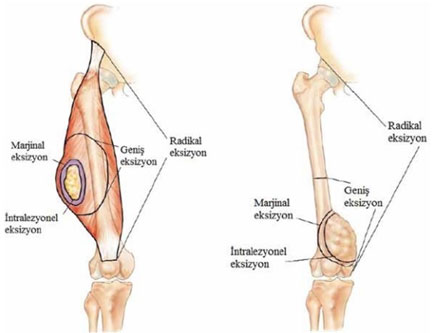PRINCIPLES OF SURGICAL TREATMENT OF BONE AND SOFT TISSUE TUMORS
- Hits: 2317
In this article, I will discuss the basic treatment principles of bone and soft tissue tumors.
RESECTION/REMOVAL OF THE TUMOR
While the first treatment method for bone and soft tissue tumors was amputation (removal of the arm or leg), local resection began to be applied in the 1940s, but the real change and development came to the fore in the 1970s with the addition of chemotherapy and radiotherapy to the treatment of malignant bone and soft tissue tumors and the development of imaging techniques and limb-sparing surgery (removal of the tumor while saving the arm or leg). The indispensable rule of limb-sparing surgery is to remove malignant bone or soft tissue tumors cleanly with wide margins.

sparing surgery is to remove malignant bone or soft tissue tumors cleanly with wide margins.
The most widely accepted classification regarding the principles of surgical treatment of bone and soft tissue tumors is that defined by Enneking. Oncologic margins are defined as intracapsular/intralesional, marginal, wide, and radical.
1. Intracapsular:
It is a method of internal scraping (curettage) of the tumor, used especially in benign bone tumors, which we call benign. In case of locally aggressive tumors (giant cell tumor, aneurysmal bone cyst, osteoblastoma, chondroblastoma), additional adjuvant methods (burr, phenol, alcohol, cautery, liquid nitrogen, hydrogen peroxide) are used after rough curettage to reduce the risk of tumor recurrence.
2. Marginal:
It is the removal of the tumor together with its capsule in one piece. Since reactive tissue is not removed, it is not preferred in malignant tumors as the surgical margin may be positive. This method is often preferred for benign soft tissue tumors (lipoma, schwannoma, myxoma, hemangioma etc.) and benign bone tumors (osteochondroma etc.). It is mandatory for some primary malignant tumors of the spine.
3. Wide resection:
It is the removal of the tumor together with the surrounding reactive and some intact tissues. If there is neurovascular invasion (invasion of the main vessel or nerve), it is resected together and then reconstruction is performed. It is preferred for malignant tumors.
4. Radical resection:
It is the removal of the entire compartment (bone and muscle) where the tumor is located. Satellite and skip lesions are also removed.
5. Amputation:
It must be performed in cases where limb-sparing surgery is not feasible.
RECONSTRUCTION OF THE CAVITY AFTER TUMOR REMOVAL
For soft tissue reconstructions:
- The goal is to close the skin in soft tissue. Skin grafts, local or distant (free) flaps can be used for this purpose.
- Autologous (saphenous) or synthetic grafts may be used for vascular reconstruction.
- Nerve reconstruction is rarely performed and the sural or saphenous nerve is often preferred.
- For tendon reconstruction, tendon transfers are usually preferred.
For bone/joint reconstructions:
- Non-biologic: prostheses/tumor resection prostheses, implants (plates, screws, nails, etc.) or bone cement (synthetic grafts are used)
- Biologic: This can be done by salvaging the removed tumor bone with liquid nitrogen or radiotherapy, allograft (bone taken from a cadaver and used after major surgery), external fixator/Ilizarow, autograft (taking the patient’s own bone (iliac wing, vascularized fibula) and transplanting it into the cavity). These procedures may be used alone or in combination.

